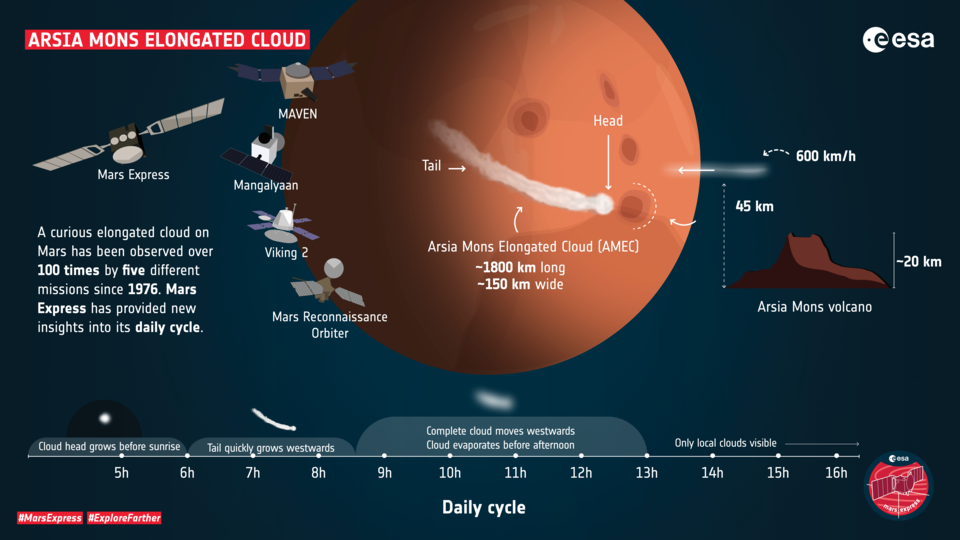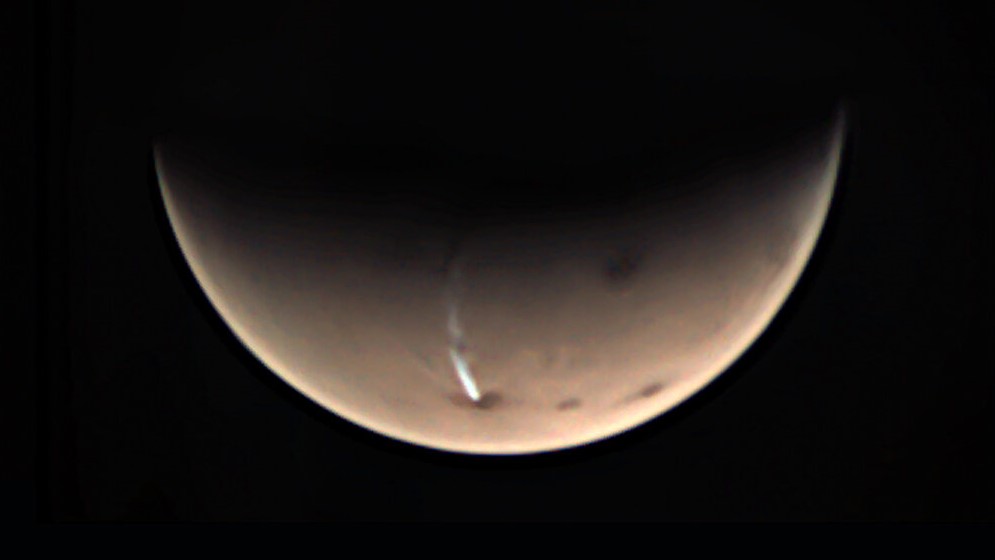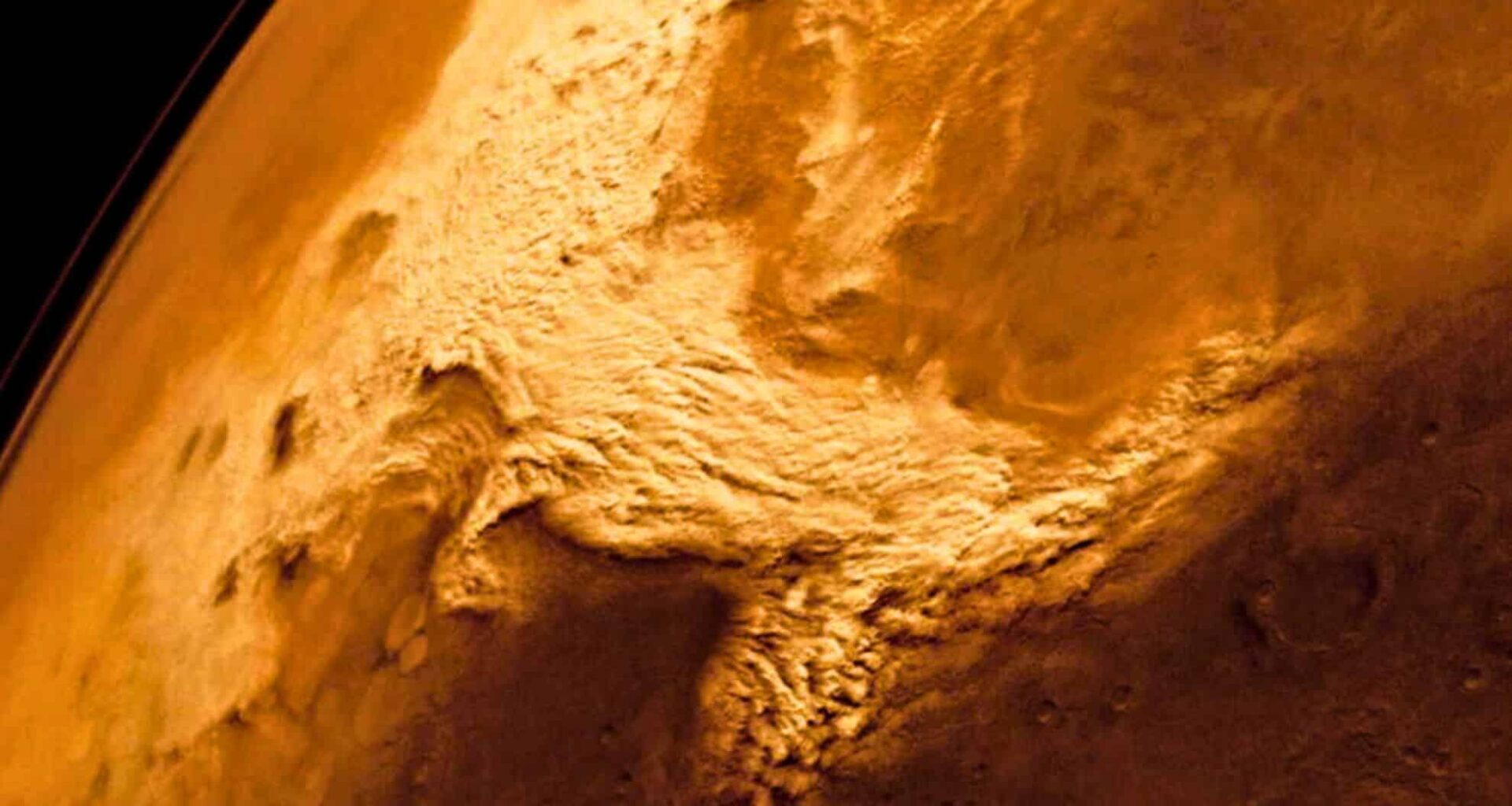Each Martian winter, a narrow white plume creeps across the planet’s Southern Hemisphere, forming just before sunrise above the massive Arsia Mons volcano. From orbit, it looks like a silvery thread unraveling in the thin atmosphere—stretching over 1,100 miles (1,770 km), longer than the entire state of California. It appears for a few hours, then vanishes by midday. For years, scientists couldn’t explain how such a formation could emerge on a planet so dry, so cold, and so thinly blanketed in air.
Mars, often romanticized as a desolate red rock, has always harbored atmospheric quirks. But this cloud—known formally as the Arsia Mons Elongated Cloud (AMEC)—stood out. First observed by the European Space Agency’s Mars Express orbiter in the early 2000s, the cloud seemed to defy Martian physics. Its recurring nature baffled researchers who, despite complex simulations, failed to replicate its shape or behavior under Mars’s known atmospheric conditions.

For nearly two decades, the best minds in planetary science had no satisfying explanation. Why would a thin, ribbon-like cloud form precisely in the same place, at the same time, every Martian year? What drove it to stretch so far yet remain so narrow, and why would it vanish so quickly? A recent study by an international team of researchers, led by atmospheric scientist Jorge Hernández-Bernal of the Université Paris-Sorbonne, may finally provide answers—and they’re as surprising as the cloud itself.
Unexpected Moisture in the Martian Air
The breakthrough came not from a new spacecraft or discovery, but from a reevaluation of how much water vapor might actually exist in the Martian atmosphere. For years, models assumed that Mars was too dry for significant cloud formation without the presence of airborne dust particles. But when Hernández-Bernal’s team dramatically increased the amount of water vapor in their simulations—levels far higher than previously accepted—they finally recreated a virtual version of the cloud that closely matched real-world observations.

This shift in understanding hinges on a phenomenon called homogeneous nucleation, a process in which water vapor condenses directly into ice crystals without the need for dust to act as a nucleus. On Earth, this rarely occurs because dust, pollen, and salt particles offer plenty of surfaces for condensation. Mars, however, is different. While it’s dusty, the density of the atmosphere is so low that condensation struggles to occur through typical mechanisms.
The idea that Mars might contain localized pockets of extreme humidity—enough to trigger such a rare process—is a striking departure from long-held assumptions. It suggests that even in the planet’s thin air, conditions can briefly mimic those of Earth-like weather systems, especially near high-altitude terrains like Arsia Mons.
A Cloud Shaped by Martian Geography
The topography of Arsia Mons, an extinct volcano nearly twice the height of Mount Everest, plays a crucial role in AMEC’s formation. As cold morning air rushes up the western slope, it cools rapidly, creating a narrow channel where supersaturated air condenses into a cloud. By mid-morning, as temperatures rise and winds shift, the delicate balance dissolves, and the cloud disappears.

This kind of orographic cloud formation is not unusual on Earth—similar patterns occur near mountainous regions like the Andes or the Alps—but on Mars, the scale and recurrence are unmatched. The difference is that AMEC doesn’t form as part of a global weather system. It’s a local phenomenon, tied tightly to Arsia Mons and the brief window of Martian dawn.
According to the study published in Geophysical Research Letters, the cloud appears during the Martian southern solstice, when sunlight hits the volcano at just the right angle and intensity. The repetition is so precise that satellites can predict its appearance to within a few sols (Martian days).
Redefining What We Know About Martian Weather
The discovery opens new questions about how dynamic and variable Mars’s atmosphere really is. If vapor-rich zones exist near volcanoes or crater rims, they might play a role in Mars’s seasonal changes—possibly influencing dust storms, frost cycles, or even the stability of subsurface ice. It also hints at unknown reservoirs or pathways for water transport in the atmosphere, with implications for future missions seeking signs of life or planning long-term human exploration.
In 2020, NASA’s Mars Climate Sounder aboard Mars Reconnaissance Orbiter detected elevated humidity levels in the southern highlands during dawn, supporting the idea that water vapor can build up under the right conditions. ESA’s ExoMars Trace Gas Orbiter has also picked up subtle fluctuations in water isotopes, further suggesting Mars’s air is more complex than a static, frozen desert.
Scientists are now working to refine climate models using these new parameters. If homogeneous nucleation is confirmed more broadly, it would mean Mars is capable of forming clouds in ways Earth cannot, offering rare insight into atmospheric processes beyond our planet.

